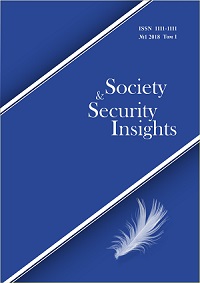Риск социальной эксклюзии и социальная безопасность лиц пожилого возраста в регионах России
Основное содержание статьи
Аннотация
В статье представлены результаты построения и апробации модели для оценки риска социальной эксклюзии населения старших возрастных групп регионов России в контексте сохранениях их социальной безопасности на основе социологического исследования, проведенного в 2016 г. в Алтайском и Забайкальском краях, Кемеровской области (779 человек 55 (женщины) и 60 (мужчины) лет и старше). Теоретически предложенная модель основана на следующем: она определяется депривацией социально-экономической (материальной), социальных прав (доступ к социальным институтам и услугам) и безопасности (безопасная среда), социального участия, культурной (нормативной) дезинтеграцией и социальным аутизмом. Названные компоненты и индикаторы специфичны для группы индивидов пенсионного возраста, которая a priori потенциально является группой риска социальной исключенности. Риск социальной эксклюзии как состояние и ситуация исключенности может быть прямо измерен через выраженность компонентов модели. Модель имеет одностороннюю казуальность, то есть выраженность одного из индикаторов компонентов эксклюзии может привести к большей выраженности социальной эксклюзии. На основе операционализированных компонентов социальной эксклюзии проведен расчет как индекса компонентов, так и общего индекса социальной эксклюзии пожилых, в том числе его региональные сравнения.
Скачивания
Metrics
Детали статьи
Authors retain the copyright of their manuscripts, and all Open Access articles are distributed under the terms of the Creative Commons Attribution License, which permits unrestricted use, distribution, and reproduction in any medium, provided that the original work is properly cited.
Литература
Bashkireva, A.S., Vylegzhanin, S.V., Kachan, E.Yu. (2016). Actual problems of social gerontology at the present state of development of Russia. Gerontology advances, vol. 29, № 2, 379–386.
Grigoryev, I.A., Bikkulov, A.S. (2015). Ageing, health and active longevity: semantic context other mentioning in social networks. Gerontology advances, vol. 28, № 2, 354–359.
Elyutina, M.V. (2015).The elderly age persons: relation to death and tantric anxiety, Sociological researches, no 10, 111–119.
Kasnova, O. V. (2014). Retirement and identity of women. Psychological researches, vol. 7, no 35, 6. URL: http://psystudy.ru (available at the date: 24.05.2017).
Maximova, S.G., Noyanzina, O.E., Maximova, M.M., Scheglova, D.K. (2015). Soial exclusion of the elderly age groups: social-economic aspects. Altai State Agrarian University Bulletin, no 5 (127), 180–184.
Maximova, S.G., Omechenko, D.A., Avdeeva, G.S. etc. (2012). Empirical models of perception of the ageing in conditions of a new gerontology reality: comparative analysis of results of sociological research in four Russian regions. The Altai State University News, no 2–2(74), 242–245.
Saponov, D.I., Smolkin, А.А. (2012). Social exclusion of the elderly: to the working out of the model of estimation. Monitoring, no 5 (111), 83–94.
Structural modelling in the SPSS AMOS [Electronic Resource] moodle.herzen.spb.ru (available at the date: 29.10.2016).
Bonfatti, A., Celidoni, M., Weber, G., Börsch-Supan, A. (2015). Coping with risks during the great recession. In: Börsch-Supan A., Kneip T., Litwin H. et al. (eds). Ageing in Europe – supporting policies for an inclusive society. (Pр. 225–234). Boston: De Gruyter.
Dahlberg, L., McKee, K.J. (2014). Correlates of social and emotional loneliness in older people: evidence from an English community study. Aging Mental Hlth, vol. 18, 504–514.
Delfani, N., De Deken, J., Dewilde, C. (2015). Poor because of low pensions or expensive housing? The combined impact of pension and housing systems on poverty among the elderly. Int. J. Hous. Policy, no 15, 260–284.
Hrast, M.F., Mrak, A.K., Rakar, T. (2013). Social exclusion of elderly in Central and Eastern Europe. Int. J. Soc. Econ., no 40, 971–989.
Hu, L., Bentler, P.M. (1999). Cutoff criteria for fit indexes in covariance structure analysis: Conventional criteria versus new alternatives. Structural Equation Modeling, vol. 6 (1), 1–55.
Kingston, P.W. (2001). The unfulfilled promise of cultural capital theory. Sociol. Educat, vol. 74, 88–99.
Milbourne, P., Doheny, S. (2012). Older people and poverty in rural Britain: material hardships, cultural denials and social inclusions. J. Rural. Stud, vol. 28, 389–397.
Myck, M., Najsztub, M., Oczkowska, M. (2015). Measuring social deprivation and social exclusion. In: Börsch-Supan A., Kneip T., Litwin H. et al. (eds). Ageing in Europe – supporting policies for an inclusive society. (Pр. 67–78). Boston: De Gruyter.
Najsztub, M., Bonfatti, A., Duda, D. (2015). Material and social de-privation in the macroeconomic context. In: Börsch-Supan A., Kneip T., Litwin H. et al. (eds). Ageing in Europe – supporting policies for an inclusive society. (Pр. 79–90). Boston: De Gruyter.
Ogg, J., Renaut, S. (2012). Social inclusion of elders in families. In: Scharf T., Keating N. (eds.) From exclusion to inclusion in old age: a global challenge. (Pр. 89–108). Bristol: Policy Press.
Popay, J., Escorel, S., Hernández, M. et al. (2008).Understanding and tracking social exclusion: final report to the WHO Commission on Social Determinants of Health. (P. 207). Lancaster: Social Exclusion Knowledge Network.
Rozanova, J., Keating, N., Eales, J. (2012). Unequal social engagement for older adults: constraints on choice. Canad. J. Aging, vol. 31, 25–36.
Scharf, T., Keating, N. (2012). Social exclusion in later life: a global challenge. In: Scharf T., Keating N. (eds.) From exclusion to inclusion in old age: a global challenge.( Pр. 1–16). Bristol: Policy Press.
Serrat, R., Villar, F., Celdrán, M. (2015). Factors associated with Spanish older people’s membership in political organizations: the role of active aging activities. Europ. J. Ageing, vol. 12, 239–247.
Victor, C.R., Bowling, A. (2012). A longitudinal analysis of loneliness among older people in Great Britain. J. Psychol, vol. 146, 313–331.
Walsh, K., Scharf, T., Keating, N. (2017). Social exclusion of older persons: a scoping review and conceptual framework. Europ. J. Ageing, vol. 14, no 1, 81–98.
Walsh, K. (2015). Interrogating the ‘age-friendly community’ in austerity: myths, realties and the influence of place context. In: Walsh K., Carney G., Ní Léime Á. (eds.). Ageing through austerity: critical perspectives from Ireland. (P. 79–95). Bristol: Policy Press.
Warburton, J., Cowan, S., Winterton, R. et al. (2014). Building social inclusion for rural older people using information and communication technologies: perspectives of rural practitioners. Aust. Soc. Work, vol. 67, 479–494.

